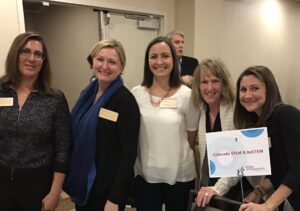There’s a popular acronym about the benefit of a TEAM, Together Everyone Achieves More. Is that a true statement, or just a cute saying? Does everyone on a team, or in an ecosystem, benefit? Participants in STEM Learning Ecosystems are answering with a resounding yes.
A few years ago, the STEM Funders Network invested in a thorough analysis of productive STEM (science, technology, engineering, mathematics) education. The resulting reports[i] concluded that:

- STEM learning must be cross-disciplinary and integrated along all learning platforms, both in and out of school, over the learning continuum from Pre-K to post-secondary to workforce.
- Only through thoughtful and strategic planning and collective efforts will young people be able to engage fully in true project-based immersive learning experiences that stimulate their interest, enthusiasm and engagement, leading to rigorous STEM learning.
- Young people can and should experience STEM learning everywhere.
As a result of the report findings, in 2015 the STEM Funders Network officially launched the STEM Learning Ecosystems Initiative. The goal of the initiative is to create a peer-to-peer Community of Practice which, over time, will result in diverse and broad collaborative communities that learn from each other and become the leaders in the cultivation of thriving and self-sustaining STEM Learning Ecosystems.
As the Community of Practice of STEM Learning Ecosystems grows, it is proving to be a true TEAM.
T – Together: Members from all across the country are collaborating on development of hands-on programs and immersive curriculum with a single objective: prepare today’s students to be the well-educated, effective STEM workforce of tomorrow. Ecosystems meet with each other at national convenings, share ideas on webinars, and discuss materials and programs via an online communication platform. They work together, even though they may be distant.

E – Everyone: There is no single recipe for success as an Ecosystem. Everyone who is committed to STEM education in the Ecosystem is a valued contributor: educators from PreK-20, students, scientists and mathematicians, program leaders, museum directors, employers, librarians, parents. Everyone has a contributing role in building the success of the Ecosystem, and ultimately, the students.
A – Achieves: The driving goal for the STEM Learning Ecosystems Initiative is to enable students to develop skills to thrive in the 21st century STEM workforce. With this clear objective in mind, all members of the Ecosystem are developing programs and activities that span Pre-K to college and beyond with learning opportunities in and out of the classroom. They approach education from different perspectives in order to help students achieve applicable knowledge.
M – More: Collaboration of like-minded organizations within a single geographical area and between groups of those organizations across the country is yielding faster growth, as predicted. More ideas spring up. More plans are developed and vetted. More creativity spawns engaging programs that take learning outside the classroom. More resources are available due to collaboration. And more students are motivated and educated to succeed in STEM learning.
As STEM Learning Ecosystems grow and take shape, the benefits of the TEAM are becoming evident. We look forward to increasing involvement of passionate groups and individuals who will work together to develop the next generation of STEM professionals.
Learn more about the STEM Learning Ecosystems initiative and find resources for your Ecosystem at stemecosystems.org. Join our online conversations on Twitter @STEMecosystems and #STEMecosystems and on Facebook.
[i] The reports used to develop the framework of STEM Learning Ecosystems have garnered widespread attention and have sparked robust discussion among STEM educators, policymakers, funders and other key stakeholders. They include: (1) Prepare and Inspire: K-12 Science, Technology, Engineering, and Math (STEM) Education for America’s Future a report prepared by the President’s Council of Advisors on Science and Technology; (2) How Cross-Sector Collaborations are Advancing STEM Learning (2014); (3) STEM Integration in K-12 Education: Status, Prospects, and an Agenda for Research (2014) a study by the National Academy of Engineering and the Board on Science Education of the National Research Council; and (4) STEM Learning Is Everywhere: Summary of a Convocation on Building Learning Systems (2014) report by the National Research Council.
